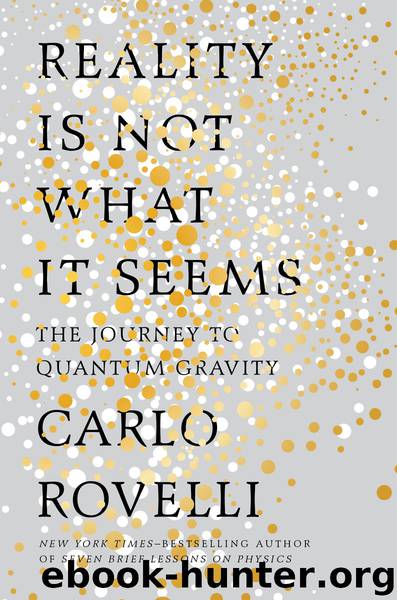Reality Is Not What It Seems by Carlo Rovelli

Author:Carlo Rovelli
Language: eng
Format: epub
Publisher: Penguin Publishing Group
Published: 2016-12-19T15:56:56+00:00
JOHN
After Matvei Bronštejn’s premature death, many of the century’s eminent physicists tried to solve the puzzle of quantum gravity. Dirac dedicated the final years of his life to the problem, opening avenues and introducing ideas and techniques on which a good part of current work on quantum gravity is based. It is thanks to these techniques that we know how to describe a world without time, as I will explain further on. Feynman tried, attempting to adapt the techniques he had developed for electrons and photons to the context of general relativity, but without success: electrons and photons are quanta in space; quantum gravity is something else: it isn’t enough to describe “gravitons” moving in space; space itself that is “quantized.”
A few Nobels were awarded to physicists who happened to resolve other problems, almost by mistake, during the course of their attempts to disentangle the puzzle of quantum gravity. Two Dutch physicists, Gerard ’t Hooft and Martinus Veltman, received the Nobel in 1999 for having shown the consistency of the theories that today are used to describe nuclear forces, a part of the Standard Model—but their research program was actually aiming to demonstrate the consistency of a theory of quantum gravity. They were working on the theories of these other forces only as a preliminary exercise. The “preliminary exercise” earned them a Nobel, but they did not succeed in showing the consistency of their version of quantum gravity.
The list could go on and would read like an honor roll of the century’s outstanding theoretical physicists. As well as like a catalogue of failures. Very gradually, though, over the course of decades, ideas were clarified and dead ends explored and usefully closed off; techniques and general ideas were strengthened, and results began to build, one developing from another. To mention here the numerous scientists who have contributed to this gradual, slow-moving collective construction would require a tedious list of names, each one of whom has added a grain or a stone to the process.
I would like to mention just one, who for years held together the threads of this collective research: the remarkable, eternally youthful Englishman—half philosopher and half physicist—Chris Isham. It was when reading one of his articles reviewing the question of quantum gravity that I first became enamored of the problem. The article explained just why it was so difficult—how our conception of space and time needed to be modified—and gave a lucid overview of all the routes that were being followed at the time, with the results achieved, and difficulties entailed. I was in my third year at university, and the possibility of rethinking space and time from square one fascinated me. This fascination has never diminished. For, as Petrarch sings: “The wound does not heal for the weakening of the bow.”
The scientist who has most contributed to quantum gravity is John Wheeler (figure 5.2), a legendary figure who has traversed the physics of the entire past century. A pupil of and collaborator with Niels Bohr in Copenhagen,
Download
This site does not store any files on its server. We only index and link to content provided by other sites. Please contact the content providers to delete copyright contents if any and email us, we'll remove relevant links or contents immediately.
The Complete Stick Figure Physics Tutorials by Allen Sarah(7134)
Secrets of Antigravity Propulsion: Tesla, UFOs, and Classified Aerospace Technology by Ph.D. Paul A. Laviolette(4972)
Thing Explainer by Randall Munroe(3782)
The River of Consciousness by Oliver Sacks(3409)
The Order of Time by Carlo Rovelli(3071)
How To by Randall Munroe(2911)
I Live in the Future & Here's How It Works by Nick Bilton(2838)
A Brief History of Time by Stephen Hawking(2817)
What If?: Serious Scientific Answers to Absurd Hypothetical Questions by Randall Munroe(2542)
The Great Unknown by Marcus du Sautoy(2532)
Midnight in Chernobyl by Adam Higginbotham(2384)
Blockchain: Ultimate Step By Step Guide To Understanding Blockchain Technology, Bitcoin Creation, and the future of Money (Novice to Expert) by Keizer Söze(2377)
Networks: An Introduction by Newman Mark(2264)
The Meaning of it All by Richard Feynman(2213)
Easy Electronics by Charles Platt(2204)
The Tao of Physics by Fritjof Capra(2162)
Midnight in Chernobyl: The Untold Story of the World's Greatest Nuclear Disaster by Adam Higginbotham(2074)
When by Daniel H Pink(2019)
Introducing Relativity by Bruce Bassett(2015)
